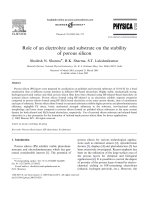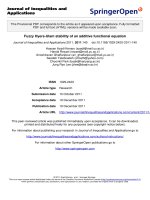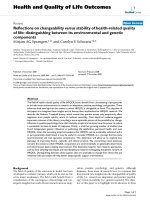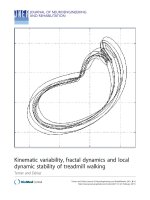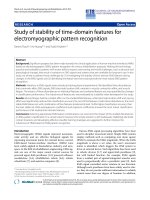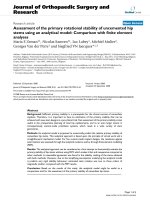Exponential stability of hopfield conformable fractionalorder polytopic neural networks
Bạn đang xem bản rút gọn của tài liệu. Xem và tải ngay bản đầy đủ của tài liệu tại đây (385.57 KB, 7 trang )
TNU Journal of Science and Technology
227(07): 49 - 55
EXPONENTIAL STABILITY OF HOPFIELD CONFORMABLE FRACTIONALORDER POLYTOPIC NEURAL NETWORKS
Mai Viet Thuan1*, Nguyen Thanh Binh2
1TNU
- University of Sciences, 2Le Quy Don High School, Haiphong
ARTICLE INFO
Received: 28/02/2022
Revised: 19/4/2022
Published: 21/4/2022
KEYWORDS
Conformable FONNs
Fractional Lyapunov theorem
Convex polytopic uncertainty
Fractional exponential stability
LMIs
ABSTRACT
Due to many reasons such as linear approximation, external noises,
modeling inaccuracies, measurement errors, and so on, uncertain
disturbances are usually unavoidable in real dynamical systems.
Convex polytopic uncertainties are one of a kind of these disturbances.
In this paper, we consider the problem of fractional exponential stability
for a class of Hopfield fractional-order neural networks (FONNs)
subject to conformable derivative and convex polytopic uncertainties.
By using the fractional Lyapunov functional method combined with
some calculations on matrices, a new sufficient condition on fractional
exponential stability for conformable FONNs is established via linear
matrix inequalities (LMIs), which therefore can be efficiently solved in
polynomial time by using the existing convex algorithms. The proposed
result is quite general and improves those given in the literature since
many factors such as conformable fractional derivative, convex
polytopic uncertainties, exponential stability, are considered. A
numerical example is provided to demonstrate the correctness of the
theoretical results.
TÍNH ỔN ĐỊNH MŨ CỦA MẠNG NƠ RON PHÂN THỨ HOPFIELD PHÙ HỢP
TỔ HỢP LỒI
Mai Viết Thuận1*, Nguyễn Thanh Bình2
1Trường
2Trường
Đại học Khoa học - ĐH Thái Ngun
THPT Lê Q Đơn, Hải Phịng
THƠNG TIN BÀI BÁO
Ngày nhận bài: 28/02/2022
Ngày hồn thiện: 19/4/2022
Ngày đăng: 21/4/2022
TỪ KHĨA
Mạng nơ ron Hopfiled phân thứ
Định lý Lyapunov phân thứ
Nhiễu tổ hợp lồi
Ổn định mũ
Bất đẳng thức ma trận tuyến tính
TĨM TẮT
Nhiễu thường xuyên xuất hiện trong các hệ động lực trong thực tế
bởi nhiều nguyên nhân như quá trình xấp xỉ tuyến tính, lỗi do đo đạc,
lỗi trong q trình mơ hình hóa. Nhiễu dạng tổ hợp lồi là một trong
những loại nhiễu này. Trong bài báo này, chúng tôi nghiên cứu tính
ổn định mũ cho một lớp mạng nơ ron Hopfield phân thứ phù hợp với
nhiễu dạng tổ hợp lồi. Bằng cách sử dụng phương pháp hàm
Lyapunov cho hệ phương trình vi phân phân thứ kết hợp với một số
phép biến đổi trên ma trận, một điều kiện đủ cho tính ổn định mũ của
mạng nơ ron Hopfiled phân thứ phù hợp được thiết lập dưới dạng bất
đẳng thức ma trận tuyến tính. Điều kiện này có thể giải hiệu quả
trong thời gian đa thức bởi các thuật toán tối ưu lồi. Các điều kiện
được đưa ra ở đây tổng quát và cải tiến so với một số kết quả đã có
bởi vì một số yếu tố như đạo hàm phân thứ phù hợp, nhiễu dạng tổ
hợp lồi, tính ổn định mũ đã được xét đến. Một ví dụ số được đưa ra
để minh họa cho tính chính xác của kết quả lý thuyết thu được.
DOI: />*
Corresponding author. Email:
49
Email:
TNU Journal of Science and Technology
227(07): 49 - 55
1. Introduction
The interest in fractional-order neural networks (FONNs) has grown rapidly due to their
successful applications in different areas such as mathematical modeling, pattern recognition, and
signal processing [1]-[4].
Investigating the stability analysis of FONNs is one of the important problems and many
interesting results have been published in the literature [5]-[9]. With the help of the fractionalorder Lyapunov direct method, the authors in [5] derived stability conditions in terms of LMIs for
Caputo FONNs. The results in [5] were extended to Caputo FONNs with time delays by Y. Yang
et al. [6]. Using the S-procedure technique and fractional Razumikhin-type theorem, the authors
in [7] proposed an LMI-based stability condition for delayed Caputo FONNs. The problem of
stability analysis for some kinds of FONNs such as complex-valued projective FONNs, and
neutral type memristor‐based FONNs have been considered in [8] and [9], respectively. It should
be noted that almost all of the existing results on the problem are focused on Caputo FONNs or
Riemann-Liouville FONNs (see [5]-[9] and references therein), and very few works are devoted
to conformable FONNs [10], [11]. With the help of the Lyapunov functional method, the authors
in [10] considered existence, uniqueness, and exponential stability problems for Hopfield FONNs
subject to conformable fractional derivatives. Note that their results are in terms of matrices
elements, which cannot propose the condition in terms of the whole matrix. Recently, the authors
in [11] derived some conditions to guarantee stability analysis of Hopfield conformable FONNs
subject to time-varying parametric perturbations. The conditions are in terms LMIs that are
numerically tractable. It is worth noticing that the convex polytopic uncertainties are not
considered in the model of the paper [10], [11]. To the best of our knowledge, the problem of
fractional exponential stability for conformable FONNs with convex polytope uncertainties has
not yet been addressed in the literature.
In this paper, we present a novel approach to study the problem of fractional exponential
stability of Hopfield conformable FONNs with convex polytopic uncertainties. Our approach is
based on using conformable fractional-order Lyapunov theorem and LMIs techniques.
Consequently, a new criterion for the problem is established. Moreover, a numerical example is
given to show that our results are less conservative than the results in [11].
Notations: A matrix P is symmetric positive definite, write P 0, if P = PT , and
y T Py 0, for all y
n
, y 0. min and max denote the minimum and maximum eigenvalues
respectively. Let S+ and S++ stand for the set of symmetric semi-positive definite matrix and
n n
, respectively.
symmetric positive definite matrices in
2. Preliminaries and Problem statement
First, we recal definition of conformable fractional derivative [1].
Definition 1 [12] Let a function g : 0, + ) → , the conformable fractional derivative of
the function g of order ( 0,1) is defined by T g ( t ) = lim
→0
T g ( t ) exists on
( 0, + ) , then
g ( t + t1− ) − g ( t )
, t 0. If
T g ( 0 ) = lim+ T g ( t ) . If the conformable fractional
derivative g ( t ) of order exists on
t →0
( 0, + ) , then the function g ( t ) is said to be −
differentiable on the interval ( 0, + ) .
50
Email:
TNU Journal of Science and Technology
For a vector function x ( t ) = ( x1 ( t ) ,
227(07): 49 - 55
, xn ( t ) )
T
n
, the conformable fractional derivative
of x ( t ) is defined for each component as follows
T x ( t ) := (T x1 ( t ) ,
, T xn ( t ) ) .
T
P1 [12]: For any scalars a, b , and two functions f1 , f 2 : 0, + ) →
T
( af ( t ) + bf ( t ) ) = aT
1
2
, we have
f1 ( t ) + bT f 2 ( t ) , t 0, 0 1.
P2 [13]: Let y : 0, + ) →
n
such that T y ( t ) exists on [0, ∞) and R S++ . Then, we
have T yT ( t ) Ry ( t ) exists on [0, ∞) and
T yT ( t ) Ry ( t ) = 2 yT ( t ) RT y ( t ) , t 0, 0 1.
Consider the following Hopfield conformable fractional order polytopic neural networks
(NNs)
T y ( t ) = − A ( ) y ( t ) + W ( ) g ( y ( t ) ) , t 0
y ( 0 ) = y0 ,
where ( 0,1 is the order of system (1), y ( t ) = ( y1 ( t ) , , yn ( t ) )
(
g ( y ( t ) ) = g1 ( y1 ( t ) ) ,
networks, y0
n
)
, g n ( yn ( t ) )
n
(1)
n
is the state vector,
stand for the neuron activation function of the
is the initial condition. The system matrices A ( ) , W ( ) are belong to a
polytope given by
N
N
= A, W ( ) := i Ai , Wi , i = 1, i 0 ,
i =1
i =1
i
i
n
i
ak 0, k = 1,
with verticesAi , Wi , where Ai = diag a1 , , an
are given diagonal matrices, Wi
i ( i = 1,
( j = 1,
,N)
n
( i = 1,
are time-invariant. The
, n ) , and Lipschitz condition on
(
, n, i = 1,
,N)
, N ) are given constant matrices, parameters
functions
g j ( .)
are continuous, g j ( 0 ) = 0,
with Lipschitz constants j 0 :
g j ( a ) − g j ( b ) j a − b , a, b , j = 1,
, n.
(2)
Definition 2 [13] System (1) is said to be fractional exponentially stable if
y ( t ) K y0 e
−
t
, t 0, 0 1.
Let us recall the following useful well-known lemma.
Lemma 1 [13] The system (1) is fractional exponentially stable if there exist
such that the following
k 0 ( k = 1, 2,3) , and a continuous function V : + n →
conditions hold
( i ) 1 y V ( t , y ) 2 y ,
( ii ) V ( t , y ( t ) ) is − differentiable on the interval ( 0, + ) ,
2
( iii ) T V ( t , y ) −3 y .
2
2
3. Main Results
51
Email:
TNU Journal of Science and Technology
Let S S+ , Pi S++ ( i = 1,
227(07): 49 - 55
, N ) , we denote L = diag 1 ,
,n,
N
S 0
P ( ) = i Pi , S =
,
i =1
0 0
where i ( i = 1,
Section 2.
Theorem
1
S S , Pi S
+
++
The
( i = 1,
− AT P − P j A i + LT L P j Wi
i ( A i , Wi , P j ) = i j
,
WiT P j
− I
, n ) are Lipschitz constants, other scalars and matrices are defined as in
system (1) is fractional exponentially stable if there exist
, N ) , and a scalar 0 such that the following conditions hold:
i ( Ai , Wi , Pi ) − S , i = 1, 2,
i ( Ai , Wi , Pj ) + j ( A j , Wj , Pi )
, N,
2
S, i = 1,
N −1
(3)
, N − 1, j = i + 1,
, N.
(4)
Proof. Let us consider the following Lyapunov function
V ( t ) = V ( t , y ( t ) ) = yT ( t ) P ( ) y ( t ) , t 0.
It is clear that
1 y ( t ) V ( t , y ( t ) ) 2 y ( t ) , t 0,
2
2
where 1 = min min ( Pi ) , 2 = max max ( Pi ). So condition (i) in Lemma 1 is
i =1, , N
i =1, , N
guaranteed. Using property P2, we calculate the − order conformable derivative of V ( t ) along
the trajectories of the system (1) as follows:
T V ( t ) = 2 y T ( t ) P ( ) T y ( t )
= yT ( t ) −P ( ) A ( ) − AT ( ) P ( ) y ( t )
(5)
+ 2 y T ( t ) P ( ) W ( ) g ( y ( t ) ) .
With the help of Cauchy matrix inequality and condition (2), we obtain
2 yT ( t ) P ( ) W ( ) g ( y ( t ) )
−1 yT ( t ) P ( ) W ( ) WT ( ) P ( ) y ( t ) + g T ( y ( t ) ) g ( y ( t ) )
y
−1 T
(6)
( t ) P ( ) W ( ) W ( ) P ( ) y ( t ) + y ( t ) L Ly ( t ) .
T
T
T
From (5) and (6), we have
T V ( t ) y T ( t ) ( ) y ( t ) ,
where
( ) = −P ( ) A ( ) − AT ( ) P ( ) + −1P ( ) W ( ) WT ( ) P ( ) + LT L.
Hence
T V ( t ) max ( ( ) ) y ( t ) , t 0.
2
(7)
Using Schur Complement Lemma [14], ( ) 0, if
52
Email:
TNU Journal of Science and Technology
227(07): 49 - 55
P ( ) W ( )
H ( )
H ( ) = T 11
0,
− I
W ( ) P ( )
T
where H11 ( ) = −P ( ) A ( ) − A ( ) P ( ) .
Since P ( ) =
N
N
i =1
i =1
N
N
i =1
i =1
i Pi , A ( ) = i Ai , W ( ) = i Wi , i = 1, i 0, we have
N
N −1
i =1
i =1 j =i +1
H ( ) = i2 i ( Ai , Wi , Pi ) + i j i ( Ai , Wi , Pj ) + j ( A j , Wj , Pi ).
N
It follows from (3) and (4) that
N
H ( ) − i2 S +
i =1
N 2
2 N −1 N
2 N −1 N
S
=
−
+
i j S .
i
i j
N − 1 i =1 j =i +1
N − 1 i =1 j =i +1
i =1
From the relation
N
N −1
i =1
i =1 j =i +1
N −1
( N − 1) i2 − 2 i j = (i − j )
N
N
2
0,
i =1 j =i +1
we have
N 2
2 N −1 N
i j S 0,
− i +
N − 1 i =1 j =i +1
i =1
which implies that ( ) 0 provided the conditions (3) and (4) hold. Since ( ) 0, there
exists a scalar 0 such that T V ( t ) − y ( t ) , t 0. Therefore, the conditions (ii) and
2
(iii) in Lemma 1 are satisfied. Therefore, system (1) is fractional exponentially stable by Lemma 1.
Remark 1 Noted here that almost all of the existing results on exponential stability problems
of dynamic systems with convex polytopic uncertainties are focused on integer-order systems
[15]-[18], and few works are considered fractional-order systems subject to Caputo fractional
derivative [19]-[21], not deal with fractional-order systems with conformable derivative.
Theorem 1 has solved the problem for Hopfield FONNs subject to conformable fractional
derivative and convex polytopic uncertainties for the first time.
When N = 1, we have the following systems
T y ( t ) = − Ay ( t ) + Wg ( y ( t ) ) , t 0
y ( 0 ) = y0 .
(8)
According to Theorem 1, the following result is obtained.
+
++
Corollary 1 The system (8) is fractional exponentially stable if there exist S S , P S ,
and a scalar 0 such that the following LMIs hold
− AT P − PAT + LT L + S PW
0.
T
W
P
−
I
Remark 2 The authors in [10] derived a stability condition in terms of matrix elements for
system (8). In this paper, the stability condition in Corollary 1 is established in the form of LMIs.
We give a numerical example to show the less conservatism of our results.
Example 1 Consider the following Hopfield conformable FONNs with ring structure [22].
53
Email:
TNU Journal of Science and Technology
227(07): 49 - 55
T y ( t ) = − Ay ( t ) + Wg ( y ( t ) ) , t 0
y ( 0 ) = y0 ,
where ( 0,1 , y ( t ) = ( y1 ( t ) , y2 ( t ) , y3 ( t ) ) 3 , and
(9)
1 −2.5
5 0 0
3
A = diag a1 , a2 , a3 = 0 4 0 , W = wij = −1 1.5
2 .
33
0 0 5
−2.5 2
−1
We choose the activation function as follows
(
g ( y ( t ) ) = tanh ( y1 ( t ) ) , tanh ( y2 ( t ) ) , tanh ( y3 ( t ) )
)
T
3
.
Noted that the function g ( y ( t ) ) satisfies the condition (2) with L = diag 1,1,1 . With the
help of LMI Control Toolbox in MATLAB [15], we can find a solution of the condition in
Corollary 1 as follows = 378.8181, and
90.0484 14.2159
P = 14.2159 118.2542
4.0217
-7.6620
4.0217
114.2390 114.4621 33.6395
-7.6620 , S = 114.4621 188.1833 -63.1433 .
33.6395 -63.1433 174.1761
96.9751
Therefor, system (8) is fractional exponentially stable for all ( 0,1 by Corollary 1. However, the
result in [10] cannot be handed in Example 1. Using some simple computation, we obtain
3
3
l =1
l =1
3
a1 = 5, l w1l = 6.5, a2 = 4, l w2l = 4.5, a3 = 5, l w3l = 5.5. So
3
l =1
l
l =1
wil ai ( i = 1, 2,3) fails to satisfy the condition
3
l =1
l
wil ai ( i = 1, 2,3) of Theorem 2 in
[10].
4. Conclusion
We have solved fractional exponential stability problem for Hopfield neural networks subject
to conformable derivative and convex polytopic uncertainties in this paper. By using the
fractional Lyapunov theorem combined with LMIs techniques, a new sufficient condition for
exponential stability has been derived. An example was given to show that our results are less
conservative than those in the existing work. In the future works, we will investigate stability
analysis of delayed neural networks with conformable fractional derivative.
REFERENCES
[1] V. T. Mai, C. H. Dinh, and T. H. Duong, "New results on robust finite-time passivity for fractionalorder neural networks with uncertainties," Neural Processing Letters, vol. 50, no. 2, pp. 1065-1078,
2019.
[2] C. Z. Aguilar, J. F. Gómez-Aguilar, V. M. Alvarado-Martínez, and H. M. Romero-Ugalde, "Fractional
order neural networks for system identification," Chaos, Solitons & Fractals, vol. 130, p.109444,
2020.
[3] B. Hu, Q. Song, and Z. Zhao, "Robust state estimation for fractional-order complex-valued delayed
neural networks with interval parameter uncertainties: LMI approach," Applied Mathematics and
Computation, vol. 373, p. 125033, 2020.
54
Email:
TNU Journal of Science and Technology
227(07): 49 - 55
[4] K. Udhayakumar, F. A. Rihan, R. Rakkiyappan, and J. Cao, "Fractional-order discontinuous systems
with indefinite LKFs: An application to fractional-order neural networks with time delays," Neural
Networks, vol.145, pp. 319-330, 2022.
[5] S. Zhang, Y. Yu, and J. Yu, "LMI conditions for global stability of fractional-order neural networks,"
IEEE Transactions on Neural Networks and Learning Systems, vol. 28, no. 10, pp. 2423-2433, 2017.
[6] Y. Yang, Y. He, Y. Wang, and M. Wu, "Stability analysis of fractional-order neural networks: an LMI
approach," Neurocomputing, vol. 285, pp. 82-93, 2018.
[7] H. Zhang, R. Ye, S. Liu, J. Cao, A. Alsaedi, and X. Li, "LMI-based approach to stability analysis for
fractional-order neural networks with discrete and distributed delays," International Journal of
Systems Science, vol. 49, no. 3, pp. 537-545, 2018.
[8] W. Huang, Q. Song, Z. Zhao, Y. Liu, and F. E. Alsaadi, "Robust stability for a class of fractional-order
complex-valued projective neural networks with neutral-type delays and uncertain parameters,"
Neurocomputing, vol. 450, pp. 399-410, 2021.
[9] M. Syed Ali, M. Hymavathi, S. Saroha, and R. Krishna Moorthy, "Global asymptotic stability of
neutral type fractional‐order memristor‐based neural networks with leakage term, discrete and
distributed delays," Mathematical Methods in the Applied Sciences, vol. 44, no. 7, pp. 5953-5973,
2021.
[10] A. Kỹtahyaloglu and F. Karakoỗ, "Exponential stability of Hopfield neural networks with
conformable fractional derivative," Neurocomputing, vol. 456, pp. 263-267, 2021.
[11] T. T. H. Nguyen, H. S. Nguyen, and V. T. Mai, "LMI conditions for fractional exponential stability
and passivity analysis of uncertain Hopfield conformable fractional-order neural networks," Neural
Processing Letters, vol. 54, no. 2, pp. 1333-1350, 2022.
[12] R. Khalil, M. Al Horani, A. Yousef, and M. Sababheh, "A new definition of fractional derivative,"
Journal of Computational and Applied Mathematics, vol. 264, pp. 65-70, 2014.
[13] A. Souahi, A. B. Makhlouf, and M. A. Hammami, "Stability analysis of conformable fractional-order
nonlinear systems," Indagationes Mathematicae, vol. 28, no. 6, pp. 1265-1274, 2017.
[14] S. Boyd, L. El Ghaoui, E. Feron, V. Balakrishnan, Linear matrix inequalities in system and control
theory, Society for Industrial and Applied Mathematics, 1994.
[15] Y. He, M. Wu, J. H. She and G. P. Liu, "Parameter-dependent Lyapunov functional for stability of
time-delay systems with polytopic-type uncertainties," IEEE Transactions on Automatic Control, vol.
49, no. 5, pp. 828-832, 2004.
[16] Y. He, Q. G. Wang, and W. X. Zheng, "Global robust stability for delayed neural networks with
polytopic type uncertainties," Chaos, Solitons and Fractals, vol. 26, pp. 1349-1354, 2005.
[17] P. Balasubramaniam and S. Lakshmanan, "Delay-interval-dependent robust-stability criteria for
neutral stochastic neural networks with polytopic and linear fractional uncertainties," International
Journal of Computer Mathematics, vol. 88, no. 10, pp. 2001-2015, 2011.
[18] K. Moezzi and A. G. Aghdam, "Delay‐dependent robust stability analysis for switched time‐delay
systems with polytopic uncertainties," International Journal of Robust and Nonlinear Control, vol. 25,
no. 11, pp. 1623-1637, 2015.
[19] S. Adelipour, A. Abooee, and M. Haeri, "LMI-based sufficient conditions for robust stability and
stabilization of LTI-fractional-order systems subjected to interval and polytopic uncertainties,"
Transactions of the Institute of Measurement and Control, vol. 37, no. 10, pp. 1207-1216, 2015.
[20] C. H. Dinh, V. T. Mai, and T. H. Duong, "New results on stability and stabilization of delayed Caputo
fractional-order systems with convex polytopic uncertainties," Journal of Systems Science and
Complexity, vol. 33, no. 3, pp. 563-583, 2020.
[21] R. Abolpour, M. Dehghani, and M. S. Tavazoei, "Reducing conservatism in robust stability analysis of
fractional-order-polytopic systems," ISA transactions, vol. 119, pp. 106-117, 2022.
[22] E. Kaslik and S. Sivasundaram, "Nonlinear dynamics and chaos in fractional-order neural networks,"
Neural Networks, vol. 32, pp. 245-256, 2012.
55
Email:

